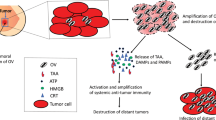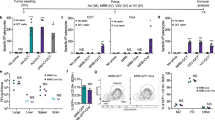Abstract
In view of the limited success of available treatment modalities for metastatic breast cancer, alternative and complementary strategies need to be developed. Oncolytic vesicular stomatitis virus (VSV) is a promising novel therapeutic agent for the treatment of cancer. The aim of this study was to evaluate the potential of recombinant VSV containing the M51R mutation in the matrix (M) protein gene administered intravenously as an effective and safe therapeutic agent for treating mice with experimental breast cancer metastases. Recombinant VSV(M51R)-LacZ was generated and characterized in vitro on human and murine breast cancer cells. Breast cancer metastases were established in immune-competent Balb/c mice by intravenous injection of syngeneic 4T1 cells. The vector was infused into the tumor-bearing animals via the tail vein, and productive infection of pulmonary breast cancer lesions was assessed by X-gal stainings of frozen lung sections. To evaluate potential systemic toxicity, histology of major organs and serum chemistries were analyzed. To assess effectiveness, buffer- or vector-treated tumor-bearing mice were followed for survival and the results were analyzed by the Kaplan–Meier method and the log-rank test. We found that VSV(M51R)-LacZ efficiently replicated and lysed human breast cancer cells but was partially attenuated in 4T1 cells in vitro. We also demonstrated that its maximum tolerated dose after intravenous infusion in normal Balb/c mice was elevated by at least 100-fold over that of the parental VSV vector containing the wild-type M gene. When VSV(M51R)-LacZ was repeatedly injected intravenously into mice bearing syngeneic 4T1 tumors, the virus was able to infect multiple breast cancer lesions in the lungs without apparent toxicities, which led to significant prolongation of animal survival (P=.003). In conclusion, systemic administration of M mutant VSV is both effective and safe in the treatment of experimental breast cancer metastases in immune-competent mice, suggesting that further development of this approach may have potential for clinical application in patients.
This is a preview of subscription content, access via your institution
Access options
Subscribe to this journal
Receive 12 print issues and online access
$259.00 per year
only $21.58 per issue
Buy this article
- Purchase on Springer Link
- Instant access to full article PDF
Prices may be subject to local taxes which are calculated during checkout





Similar content being viewed by others
References
Jemal A, Murray T, Samuels A, et al. Cancer statistics, 2003. CA Cancer J Clin. 2003;53:5–26.
Hortobagyi GN . Treatment of breast cancer. N Engl J Med. 1998;339:974–984.
Martuza RL, Malick A, Markert JM, et al. Experimental therapy of human glioma by means of a genetically engineered virus mutant. Science. 1991;252:854–856.
Bischoff JR, Kirn DH, Williams A, et al. An adenovirus mutant that replicates selectively in p53-deficient human tumor cells. Science. 1996;274:373–376.
Khuri FR, Nemunaitis J, Ganly I, et al. A controlled trial of intratumoral ONYX-015, a selectively-replicating adenovirus, in combination with cisplatin and 5-fluorouracil in patients with recurrent head and neck cancer. Nat Med. 2000;6:879–885.
Nemunaitis J, Ganly I, Khuri F, et al. Selective replication and oncolysis in p53 mutant tumors with ONYX-015, an E1B-55kD gene-deleted adenovirus, in patients with advanced head and neck cancer: a phase II trial. Cancer Res. 2000;60:6359–6366.
Ganly I, Kirn D, Eckhardt G, et al. A phase I study of Onyx-015, an E1B attenuated adenovirus, administered intratumorally to patients with recurrent head and neck cancer. Clin Cancer Res. 2000;6:798–806.
Markert JM, Medlock MD, Rabkin SD, et al. Conditionally replicating herpes simplex virus mutant, G207 for the treatment of malignant glioma: results of a phase I trial. Gene Therapy. 2000;7:867–874.
Kirn D, Martuza RL, Zwiebel J . Replication-selective virotherapy for cancer: biological principles, risk management and future directions. Nat Med. 2001;7:781–787.
Stojdl DF, Lichty B, Knowles S, et al. Exploiting tumor-specific defects in the interferon pathway with a previously unknown oncolytic virus. Nat Med. 2000;6:821–825.
Balachandran S, Barber GN . Vesicular stomatitis virus (VSV) therapy of tumors. IUBMB Life. 2000;50:135–138.
Balachandran S, Barber GN . Defective translational control facilitates vesicular stomatitis virus oncolysis. Cancer Cell. 2004;5:51–65.
Rose JK, Whitt MA . Rhabdoviridae: the viruses and their replication. In: Knipe DM, Howley PM, eds. Fields Virology. Philadelphia: Lippincott Williams & Wilkins; 2001: 1221–1242.
Marcus PI, Rodriguez LL, Sekellick MJ . Interferon induction as a quasispecies marker of vesicular stomatitis virus populations. J Virol. 1998;72:542–549.
Ferran MC, Lucas-Lenard JM . The vesicular stomatitis virus matrix protein inhibits transcription from the human beta interferon promoter. J Virol. 1997;71:371–377.
Ahmed M, McKenzie MO, Puckett S, et al. Ability of the matrix protein of vesicular stomatitis virus to suppress beta interferon gene expression is genetically correlated with the inhibition of host RNA and protein synthesis. J Virol. 2003;77:4646–4657.
Petersen JM, Her LS, Varvel V, et al. The matrix protein of vesicular stomatitis virus inhibits nucleocytoplasmic transport when it is in the nucleus and associated with nuclear pore complexes. Mol Cell Biol. 2000;20:8590–8601.
von Kobbe C, van Deursen JM, Rodrigues JP, et al. Vesicular stomatitis virus matrix protein inhibits host cell gene expression by targeting the nucleoporin Nup98. Mol Cell. 2000;6:1243–1252.
Francoeur AM, Poliquin L, Stanners CP . The isolation of interferon-inducing mutants of vesicular stomatitis virus with altered viral P function for the inhibition of total protein synthesis. Virology. 1987;160:236–245.
Desforges M, Charron J, Berard S, et al. Different host-cell shutoff strategies related to the matrix protein lead to persistence of vesicular stomatitis virus mutants on fibroblast cells. Virus Res. 2001;76:87–102.
Stojdl DF, Lichty BD, tenOever BR, et al. VSV strains with defects in their ability to shutdown innate immunity are potent systemic anti-cancer agents. Cancer Cell. 2003;4:263–275.
Obuchi M, Fernandez M, Barber GN . Development of recombinant vesicular stomatitis viruses that exploit defects in host defense to augment specific oncolytic activity. J Virol. 2003;77:8843–8856.
Shinozaki K, Ebert O, Kournioti C, et al. Oncolysis of multifocal hepatocellular carcinoma in the rat liver by hepatic artery infusion of vesicular stomatitis virus. Mol Ther. 2004;9:368–376.
Lawson ND, Stillman EA, Whitt MA, et al. Recombinant vesicular stomatitis viruses from DNA. Proc Natl Acad Sci USA. 1995;92:4477–4481.
Whelan SP, Ball LA, Barr JN, et al. Efficient recovery of infectious vesicular stomatitis virus entirely from cDNA clones. Proc Natl Acad Sci USA. 1995;92:8388–8392.
Ebert O, Shinozaki K, Huang TG, et al. Oncolytic vesicular stomatitis virus for treatment of orthotopic hepatocellular carcinoma in immune-competent rats. Cancer Res. 2003;63:3605–3611.
Morecki S, Yacovlev E, Diab A, et al. Allogeneic cell therapy for a murine mammary carcinoma. Cancer Res. 1998;58:3891–3895.
Pulaski BA, Ostrand-Rosenberg S . Reduction of established spontaneous mammary carcinoma metastases following immunotherapy with major histocompatibility complex class II and B7.1 cell-based tumor vaccines. Cancer Res. 1998;58:1486–1493.
Huang TG, Ebert O, Shinozaki K, et al. Oncolysis of hepatic metastasis of colorectal cancer by recombinant vesicular stomatitis virus in immune-competent mice. Mol Ther. 2003;8:434–440.
Charan S, Zinkernagel RM . Antibody mediated suppression of secondary IgM response in nude mice against vesicular stomatitis virus. J Immunol. 1986;136:3057–3061.
Kundig TM, Schorle H, Bachmann MF, et al. Immune responses in interleukin-2-deficient mice. Science. 1993;262:1059–1061.
Fernandez M, Porosnicu M, Markovic D, et al. Genetically engineered vesicular stomatitis virus in gene therapy: application for treatment of malignant disease. J Virol. 2002;76:895–904.
Porosnicu M, Mian A, Barber GN . The oncolytic effect of recombinant vesicular stomatitis virus is enhanced by expression of the fusion cytosine deaminase/uracil phosphoribosyltransferase suicide gene. Cancer Res. 2003;63: 8366–8376.
Bateman A, Bullough F, Murphy S, et al. Fusogenic membrane glycoproteins as a novel class of genes for the local and immune-mediated control of tumor growth. Cancer Res. 2000;60:1492–1497.
Ebert O, Shinozaki K, Kournioti C, et al. Syncytia induction enhances the oncolytic potential of vesicular stomatitis virus in virotherapy for cancer. Cancer Res. 2004;64:3265–3270.
Acknowledgements
We thank Dr John Rose of Yale University for providing pVSV-XN2 plasmid DNA, Dr Tian-Gui Huang for discussions, Dr John Fallon for consultation on histological analyses of tissue samples, and Ms Jing Xu for excellent technical assistance.
Author information
Authors and Affiliations
Corresponding author
Additional information
This work was supported in part by NIH Grant R01-CA100830 (to SLCW) and Deutsche Forschungsgemeinschaft Grant EB 234/1-1 (to OE).
Rights and permissions
About this article
Cite this article
Ebert, O., Harbaran, S., Shinozaki, K. et al. Systemic therapy of experimental breast cancer metastases by mutant vesicular stomatitis virus in immune-competent mice. Cancer Gene Ther 12, 350–358 (2005). https://doi.org/10.1038/sj.cgt.7700794
Received:
Published:
Issue Date:
DOI: https://doi.org/10.1038/sj.cgt.7700794
Keywords
This article is cited by
-
Self-replicating vehicles based on negative strand RNA viruses
Cancer Gene Therapy (2023)
-
Oncolytic viruses against cancer, promising or delusion?
Medical Oncology (2023)
-
DNA-PK inhibition synergizes with oncolytic virus M1 by inhibiting antiviral response and potentiating DNA damage
Nature Communications (2018)
-
Maraba virus-vectored cancer vaccines represent a safe and novel therapeutic option for cats
Scientific Reports (2017)
-
Aptamer-facilitated Protection of Oncolytic Virus from Neutralizing Antibodies
Molecular Therapy - Nucleic Acids (2014)



